What's new
Learn about the latest features and enhancements.
October 2024 - Raw Signing Feature Release
October 2024 - Version 5.1.0
Overview
We are excited to introduce the Raw Signing feature in Ledger Enterprise (ver. 5.1). This specialized feature allows API Operators to sign transactions on unsupported blockchains, enhancing flexibility in transaction management.
Key Highlights
- Use Cases: Sign transactions on unsupported blockchains, perform unsupported actions on supported chains, and prove messages on-chain.
- Access: Raw Signing is not included by default and is available upon request. Contact your Technical Account Manager (TAM) for eligibility.
Best Practices
To ensure secure usage, we recommend:
- Thoroughly validate transactions before submission.
- Limit access to trusted personnel.
- Regularly audit and monitor signing activities.
For more details on enabling and using Raw Signing, please refer to the documentation or reach out to your TAM.
June 2024 - Tradelink support
June 2024 - Version 5.0.0
Overview
We are excited to announce the latest Ledger Enterprise release which brings the support of Tradelink
- Tradelink is an open protocol standard to monitor, manage, pledge, and settle collateral balances secured and powered by Ledger Enterprise technology and hardware (HSM).
- Tradelink enables the creation of off-exchange trading as a service by offering a quick and easy way to set up the governance and access rights to accounts across multiple parties (multi-party governance). The Tradelink account multi-party governance defines the set of rules enforced on each party to authorize monitoring of collateral levels, creation, and approvals of collateral pledging and settlement.
Please read more about Tradelink here.
April 2024 - Proof of Ownership and Mark spam transactions enhancements
April 2024 - Version 4.34.0
Overview
We are excited to announce the latest Ledger Enterprise release (ver. 4.34), which brings following enhancements:
- Enhanced Compliance capabilities : sign Proof of Ownership messages on any network.
- Mark objects as spam : marking accounts and operations as spam and filter on them.
Enhanced Compliance capabilities: sign Proof of Ownership messages on any network
As a Ledger Enterprise user, you will now be able to define and use Message Signing capabilities across all supported networks. This enables you to sign Proof of Ownership messages, should you require it for Compliance purposes. Indeed, signing messages with a private key can be used to prove that an institution controls the private keys that correspond to its public addresses.
You can find out more about this feature in the dedicated spaces:
- for Admins : activate Message Signing on an account.
- for Operators : sign an EIP-191 compliance Message.
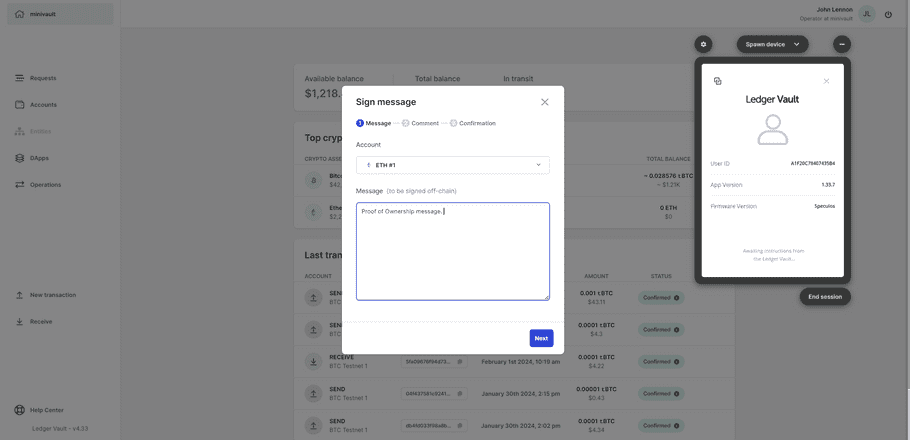
Mark objects as spam
As a Ledger Enterprise use (admin or oprator), you will now be able to mark/unmark an account or transaction as spam and then filter on this new tag. This is to reduce the risk that your operators accidentally use, in new operations, addresses from poisoning transactions. Note still that operators should always use the "receive" button to generate receive addresses safely, and not copy addresses from the operations history. Finally we strongly suggest to use whitelists systematically.
Please find more information on address poisonong scams here.
Process for marking accounts as spam:
Clicking on the button with the three dots "..." will display the context menu for you to mark or unmark an account as spam. You can find documentation for adding a label to the Account matching the ID here.
Please note that only "view-only" accounts can be marked as spam, meaning only LAM and API operators and all admins can mark accounts as spam.
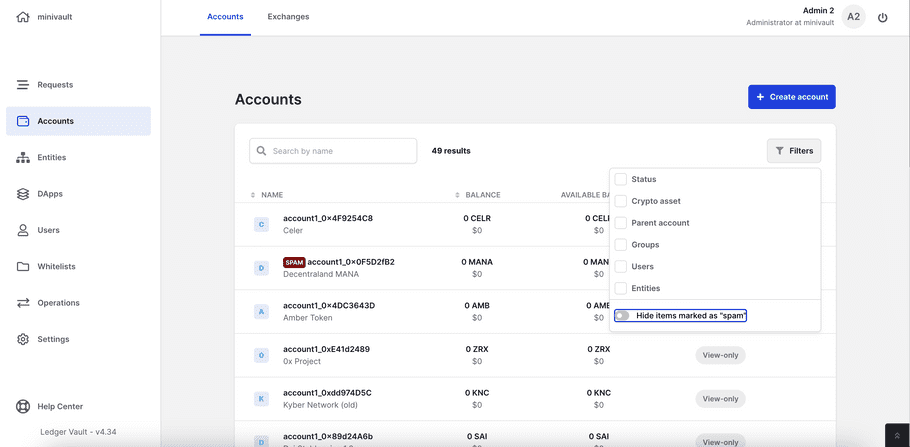
Process for marking operations as spam:
Clicking on the button with the three dots "..." will display the context menu for you to mark or unmark an operation as spam. You can find documentation for adding a label to the transactions matching the ID here.
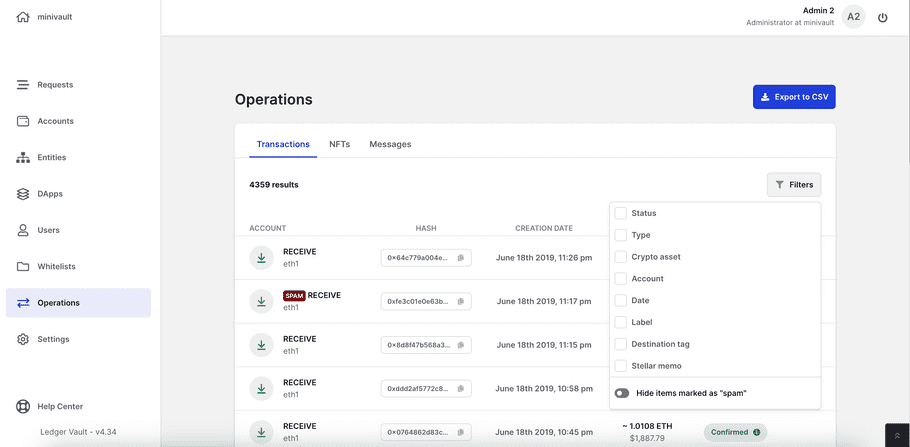
February 2024 - Enhanced API capabilities & Streamlining API user onboarding and authentication
February 2024 - Version 4.33.0
Overview
This release enables multiple API features on more granular bitcoin balances, the creation custom labels that can be used to flag transactions and accounts. We are also really proud to announce the upgrade of API operator onboarding and authentication for a streamlined API experience, please read more about this in Ledger Enterprise developer portal.
- Multiple API Improvements: We are proud to announce upgrades to our API operator onboarding and authentication processes, enhancing the overall API experience. For more details, please visit the Ledger Enterprise Developer Portal .
- Improved Balance Display on Bitcoin: Account balance details now include aggregated information on bitcoin Unspent Transaction Outputs (UTXOs). This update provides insights into whether UTXOs are currently in the mempool, in the process of confirmation, or finalized on the network. Additionally, it includes information on your dust and worthless amount, offering a more detailed overview of your Bitcoin holdings.
- Custom Labels via API: We are adding custom labels to transactions and accounts, allowing users to flag them for easier identification. Please note that this feature will be available via API and be added in the UI in a future update.
December 2023 - Compliance, Web3, Exchange and User Experience enhancement
December 2023 - Version 4.32.0
Overview
- Chainalysis full support - KYT Risk Screening : Enhanced security with Chainalysis integration for AML (Anti-Money Laundering) screening of your incoming and outgoing transactions.
- Deploy a contract from Vault UI & Wallet Connect : Enables the deployment of a contract from Vault UI, this feature was already available via API.
- Exchange Connectivity - Transfers and withdraw capabilities : Exchange Connectivity implementation enable you to trigger withdraw on exchanges from the vault.
- User Experience Enhancements : User experience improvements, including various UI enhancements.
- Holesky & Sepolia Full Support : API Support for Holesky (including staking)
Chainalysis full support - KYT Risk Screening
Enhance your Ledger Enterprise experience with the latest addition – Chainalysis KYT. Boost compliance and security effortlessly by automating transaction screening. Real-time risk monitoring in the Ledger Enterprise UI and your Compliance Tool keeps you informed, enabling swift action against potential risks. Seamless integration, simplified setup, and proactive risk management make Chainalysis KYT a powerful upgrade for a more secure and compliant transaction environment.
Please refer to the help center documentation for more information.
Deploy a contract from Vault UI & Wallet Connect
In August, we released our first version on Smart Contract Deployment, which empowers Ledger Enterprise clients to deploy Smart Contracts across EVM networks programmatically and with a dedicated governance framework for best-in-class security. We are excited to announce the launch of our new version, which lets users deploy Smart Contracts drectly from their Ledger Enterprise interface, either through a dedicated native flow or via WalletConnect.
Smart Contracts have brought new opportunities and interesting use cases to Corporates & Financial Institutions:
- For Corporates and Brands , smart contracts enable the creation and management of new digital products, such as NFTs. These new assets can be leveraged as digital twins (Dior B33 snearkers, Nike CryptoKicks), collectibles, digital certificates of authenticity... They can also enable new marketing strategies for Brands looking to engage and connect with their audience in a more meaningful fashion.
- For Financial Institutions , smart contracts offer the ability to tokenize various asset classes, automate settlement processes, and create decentralized financial products, enhancing liquidity, security, and transparence.
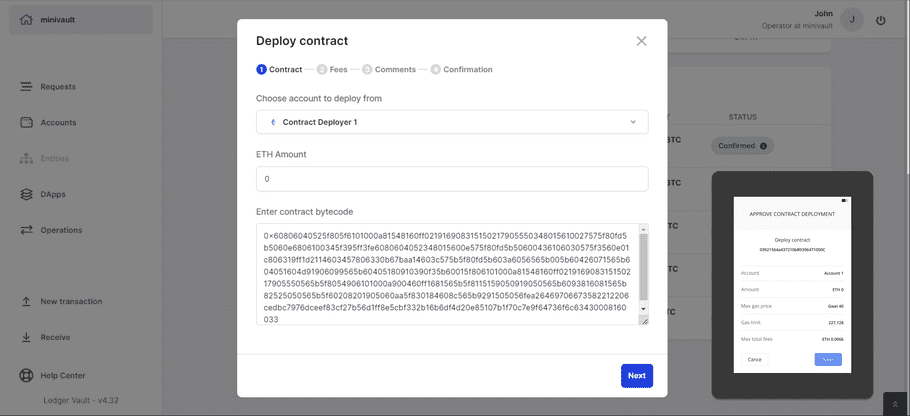
To learn more on how to deploy Smart Contract from your Ledger Enteprise workspace, please refer to the dedicated user documentation here.
Exchange Connectivity - Transfers and withdraw capabilities
In addition to existing reporting capabilities we added the support of withdraw capabilities for Binance.
- You can now initiate transfers from your exchange account directly from Ledger Enterprise UI, so that you can bring your funds to self-custody in a few click.
If you need this capability on other exchange please contact your technical account manager.
For detailed instructions and further information, please refer to the detailed documentation.
Holesky & Sepolia Full Support
We are happy to announce that Ledger Enterprise now fully supports Ethereum's main test networks, Holesky and Sepolia:
- full transaction history support
- no rate limits on network calls
- pogrammatic support to monitor & transact with Sepolia & Holesky accounts via API (including staking endpoints on Holesky).
You will therefore be able to test any application & staking operations seamlessly on these networks.
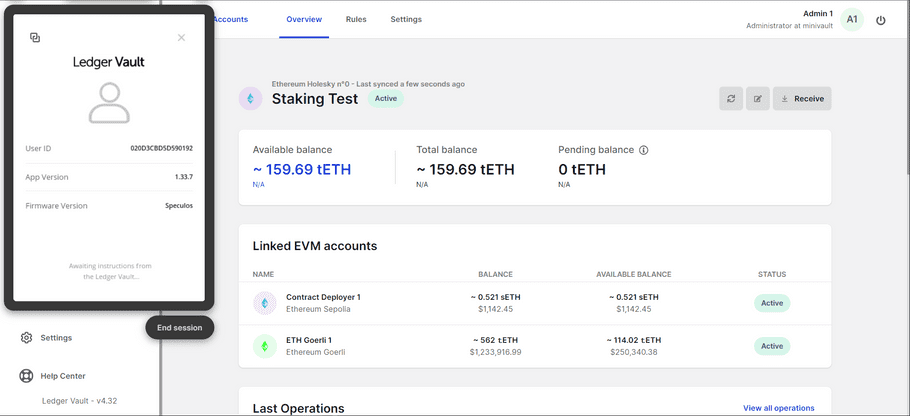
User Experience Enhancements
-
Clickable Account Names in Transaction Details:
- Users can now conveniently click on account names in transaction details for quick access.
-
Default Opening of Transaction Rules Drawer:
- For account with multiple rules, the first rule drawer is now opened by default, enhancing user interaction, especially for non-SCI/Staking accounts.
-
Revoking User Warning:
- A warning is now provided when revoking a user if it will result in canceled transactions, improving user awareness.
-
Whitelist Address Name Display on Hover:
- Whitelist address names are now displayed on hover, providing users with additional information at a glance.
-
Pending Admin User Invite Disablement:
- UI now warns user in advance that inviting another admin user is disabled if a first admin invitation is in a “pending” state, preventing error.
-
Currency Field in Account Creation:
- Replaced the "Balance" field with "Currency" during account creation for improved clarity.
-
Error Prevention for Duplicate Group Names:
- Users are now alerted and prevented from creating two groups with the same name, reducing errors.
-
Explorer Button in Transaction Table:
- An explorer button is now displayed in the transaction table, simplifying navigation.
These user-centric enhancements aim to elevate the overall user experience, providing improved usability, clarity, and functionality in the latest release.
December 2023 - TRC20 and Holesky support
December 2023
Overview
We are excited to announce the release of:
- TRC20 support: You can now custody and manage your TRC20 tokens, including USDT, on your Ledger Enterprise platform
- Direct access to Holeky: You can now interact with the Holesky test network (Ethereum)
Send and receive TRC20 tokens
We are excited to announce the further development of the Vault Signer feature to include the TRC20 tokens from the TRON Network. The Vault Signer feature enables you to utilize an external wallet for transaction crafting, subsequently enabling the Vault to verify and execute the transaction signing process. This model ensures that all transactions comply with the governance regulations enforced by the hardware security module (HSM). By seamlessly integrating this feature with Cosmos and Near coins, we are bringing increased flexibility and security to your blockchain interactions.
Learn more about the Vault Signer feature here.
Holesky Direct Access support
As announced by the Ethereum Foundation, Goerli will be deprecated in January 2024. However, two main test networks have been developped to replace it:
- Sepolia is the test network of choice to test classic execution-layer operations (SEND, ERC20, NFTs, decentralized applications, smart contracts, and other EVM functionalities);
- Holesky is the test network of choice to test staking operations.
To ensure the continuity of your staking tests, we are excited to annouce the first phase of our Holesky release. You will be able to access this network in Direct Access mode. This means that you will be able to:
- Create accounts on these newly supported networks
- View your account balances for both parent and ERC20 children accounts
- Perform basic asset transfers
API support will not be included in this first phase. However, we are actively working on fully supporting Holesky programmatically (both for classic endpoints, as well as stakingendpoints). We advise you keep your staking tests on Goerli for now, until Ledger Enterprise fully supports Holesky.
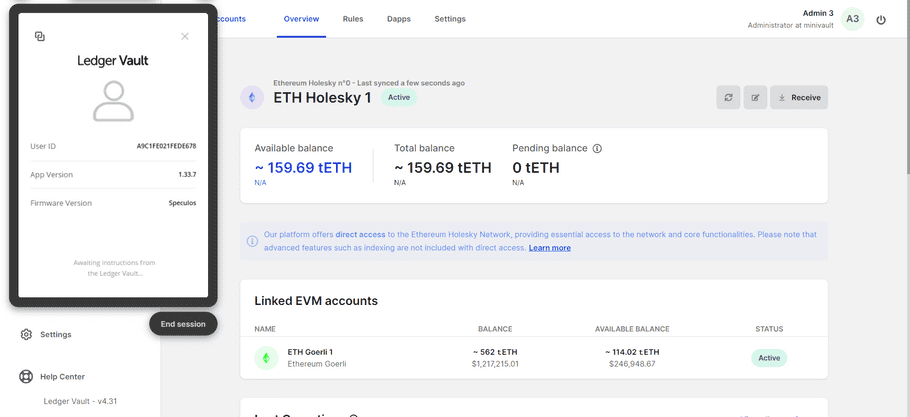
November 2023 - Laying down some groundwork
November 2023 - Version 4.31.0
Overview
This release lays the foundation for upcoming TRC-20 support via Vault Signer, which will come in a later version, as well as minor workflow changes to the initial vault onboarding process.
October 2023 - Enhanced Custody Capabilities + Chainalysis Integration
October 2023 - Version 4.30.0
Overview
- Polkadot: Introducing the Chill Feature
- Polkadot: Streamlined Staking Process After the Polkadot Network Upgrade
- Chainalysis: Address Screening for Enhanced Security
- API Enhancement: Fetch Governance History & Status via API
- New EVMs Integration: Direct Access to Additional Networks
- Secure Transaction Processing: SCI Transaction Mode
- MATIC Staking Reporting: Easily Track MATIC Staking Rewards
Introducing Polkadot Chill
We've introduced a new feature in Polkadot called "Chill." Chilling allows you to take a step back from nominating or validating activities and place your account in a chilled state. With Chill, you can now unbond the entirety of your bonded amount, previously locked by the Polkadot network's minnominated variable (valued at around 300 DOT at the time of writing). For detailed information on how to use Chill, please refer to our [documentation](../content/staking/stakingpolkadot/overview.md).
Streamlined Polkadot Staking
We've simplified the staking process following a recent Polkadot network upgrade. The most significant change is the removal of the controller account, giving full staking capabilities to the stash account. This change reduces the number of required transactions from 4 to 2, making staking more straightforward and efficient. Learn more on the Polkadot staking page.
Chainalysis Address Screening
We're excited to introduce Chainalysis Address Screening to enhance the security and compliance of your transactions. Key features include:
- Connect Compliance Tool: Seamlessly integrate your compliance provider in the settings section of our platform.
- Whitelist Address Screening: Before adding addresses to your whitelist, they will undergo screening to ensure compliance and risk mitigation.
- Address Screening in "New Transaction" Modal: When pasting a recipient address in the "New Transaction" modal, the system will screen it for added security and compliance.
This update empowers you to make informed, secure transactions while maintaining compliance.
Please refer to the help center documentation for more information.
Fetch Governance History & Status via API
We are excited to introduce a significant update to our platform with the addition of a new API endpoint: GET /requests/{request_id}/status. This new endpoint empowers you with enhanced capabilities to streamline your workspace reporting and governance workflows.
- Secure comprehensive audit trails for all workspace operations: transactions & workspace management (user, account, whitelist modifications)
- Facilitate tracking request approvals to speed up governance workflows
Please refer to the endpoint documentation for more information.
New EVMs Integration
Ledger Enterprise is excited to introduce Direct Access to new EVM networks: Celo, Cronos, Kava, and TomoChain, along with their respective test networks. This enables you to interact directly with these networks, create accounts, view balances, perform transactions, and engage with DeFi and NFT applications.
Direct Access is a support mode where the Ledger Enterprise Platform communicates directly with EVM networks. This method allows users to explore and interact with a broader array of blockchains without the need for them to be fully indexed on our platform. With Direct Access, you can:
- Create accounts on these newly supported networks
- View your account balances for both parent and ERC20 children accounts
- Perform basic asset transfers
- Engage with DeFi and NFT applications on these networks
Please note that due to the nature of Direct Access (without full indexing), reporting capabilities are currently limited to outgoing transactions. Additionally, users should be aware of potential rate limitations on transactions that might impact their ability to perform actions rapidly or in high volumes. However, we plan to enable Full Access on these networks in later iterations to provide comprehensive reporting and minimize such limitations. Until Full Access is available, users can use external tools, such as public explorers (e.g., ArbitrumScan), to retrieve additional information on their reporting.
Learn more about how to leverage these new supported networks here.
User Experience Improvement for Web3 Interactions
Since October 2022, Ledger Enterprise has brought you unparalleled security through our Clear Sign framework across all Web3 interactions (DeFi, NFT, staking, tokenization). You can review the list of supported Clear Sign applications here.
To ensure the best security and user experience while interacting with Web3 applications, we now display on your user interface whether a smart contract interaction will be Clear Signed or Blind Signed. This enables you to approve and validate your operations with full context, making informed decisions.
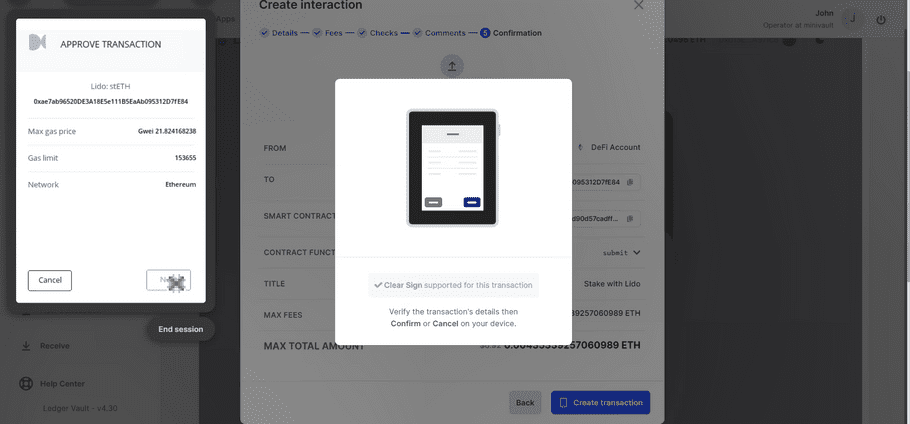
MATIC Staking Reporting via API
If you have staked MATIC, you can now easily track your rewards and staked assets on your MATIC ERC20 accounts using our GET/account endpoint. This information is available across our three staking providers (Kiln, Figment & Blockdaemon). You can now automatically track and report your total staking balances, including:
- Total staked assets (assets generating rewards)
- Total rewards earned
- Total unbonded (claimable) assets
- Total unbonding assets
Please refer to the endpoint documentation for more information.
August 2023 - Tax & Accounting: Cryptio Integration
Tax & Accounting - Cryptio Integration
You can now connect your Ledger Enterprise workspace to Cryptio's enterprise-grade accounting, audit and tax platform.
- Extract a complete & accurate historical transaction history from 25+ chains.
- Automate valuation and pricing of crypto assets in line with international audit standards.
- Automate cost basis and gain and losses computations, even at high transaction volumes.
- Reconcile on-chain movements with internal finance systems and ERP systems like Netsuite, Oracle, SAP, and more.
- Generate GAAP and IFRS-compliant reports, including Asset Roll Forwards, Trial balances, Ledger entries, and Portfolio balances.
- Implement internal controls to address completeness, accuracy & valuation risks for financial audit readiness.
August 2023 - Version 4.29.0: Smart Contract Deployment - Near and Cosmos via Vault Signer - Whitelist support for Vault Signer
August 2023 - Version 4.29.0
Overview
- Deploy Smart Contracts on Ethereum & EVMs
- Send and Receive Cosmos and Near with Vault Signer and Ledger Live
- Create whitelists on "Vault Signer" currencies (Tron, Cosmos, NEAR)
Deploy Smart Contracts on Ethereum & EVMs
Ledger Enterprise is taking another significant step in enhancing your capabilities on EVM networks. Along with sending transactions, interacting with contracts, and signing messages, we now enable users to deploy smart contracts directly from their workspace. This comprehensive functionality allows our enterprise and institutional clients to perform virtually any operation on EVM networks, with governance, security and auditability.
Smart Contracts have brought new opportunities and interesting use cases to Corporates & Financial Institutions:
- For Corporates and Brands , smart contracts enable the creation and management of new digital products, such as NFTs. These new assets can be leveraged as digital twins (Dior B33 snearkers, Nike CryptoKicks), collectibles, digital certificates of authenticity... They can also enable new marketing strategies for Brands looking to engage and connect with their audience in a more meaningful fashion.
- For Financial Institutions , smart contracts offer the ability to tokenize various asset classes, automate settlement processes, and create decentralized financial products, enhancing liquidity, security, and transparence.
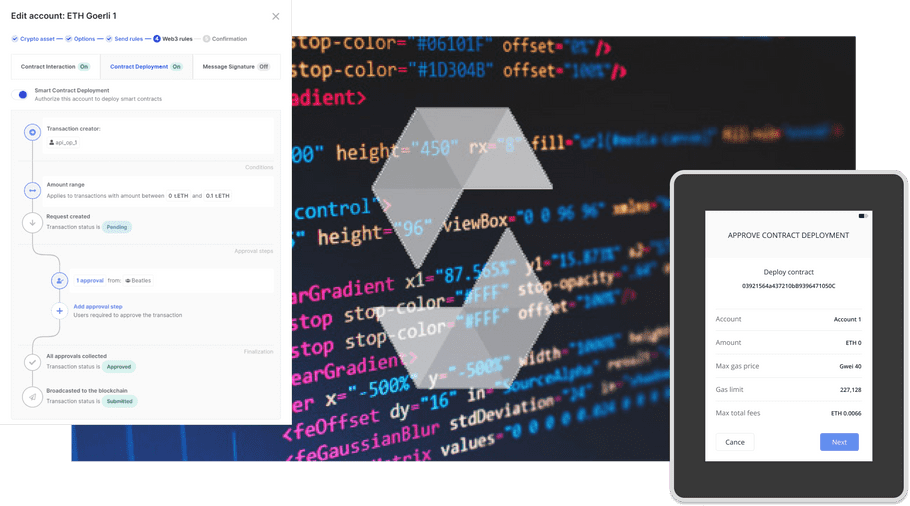
To learn more on how to deploy Smart Contract from your Ledger Enteprise workspace, please refer to the dedicated user documentation here.
Near and Cosmos via Vault Signer and Ledger Live
We are excited to announce the expansion of the Vault Signer feature to include the Cosmos (ATOM) and Near cryptocurrencies, after having first been released with Tron. This enhancement enables you to utilize an external wallet for transaction crafting, subsequently enabling the Vault to verify and execute the transaction signing process. This model ensures that all transactions comply with the governance regulations enforced by the hardware security module (HSM). By seamlessly integrating this feature with Cosmos and Near coins, we are bringing increased flexibility and security to your blockchain interactions. Learn more about the Vault Signer feature here.
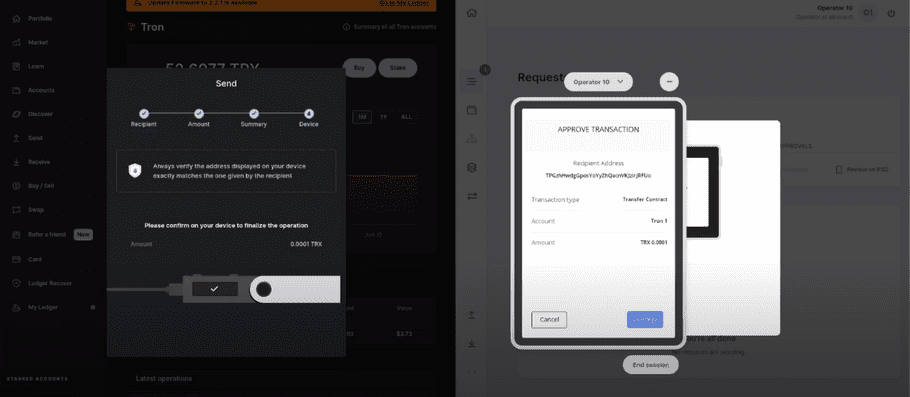
It will also be possible to stake Cosmos accounts through the Vault Signer feature, by crafting staking operations on the Ledger Live app. Learn more about staking cosmos (ATOM) here.
As well as these two new coin integrations, it is now possible to whitelist Cosmos, Tron and Near addresses, as well as listing the whitelists in the governance rules of these accounts.
July 2023 - Version 4.28.0: Connect Exchange Accounts - ETH Staking via API
July 2023 - Version 4.28.0
Overview
- Connect Exchange Accounts
- Stake Ethereum programmatically via API
Connect Exchange Accounts
Presenting the newest addition to our platform: the Exchange Account Integration feature, enabling external account monitoring within Ledger Enterprise. With this feature, you can seamlessly connect your external exchange accounts and enjoy a range of powerful tools to monitor your assets held on an exchange.
- Connect your external Exchange Accounts : Connect your external exchange accounts with API keys generated on the exchange admin panel.
- Define external Exchange Accounts rules : Implement governance rules to define specific criteria for operators to view and transfer exchange assets.
- Monitor your external Exchange Accounts : Gain a comprehensive view of your account balances in both cash and cryptocurrencies. Track the transfer history from your connected exchange accounts and maintain an audit trail of transfer requests initiated by operators.
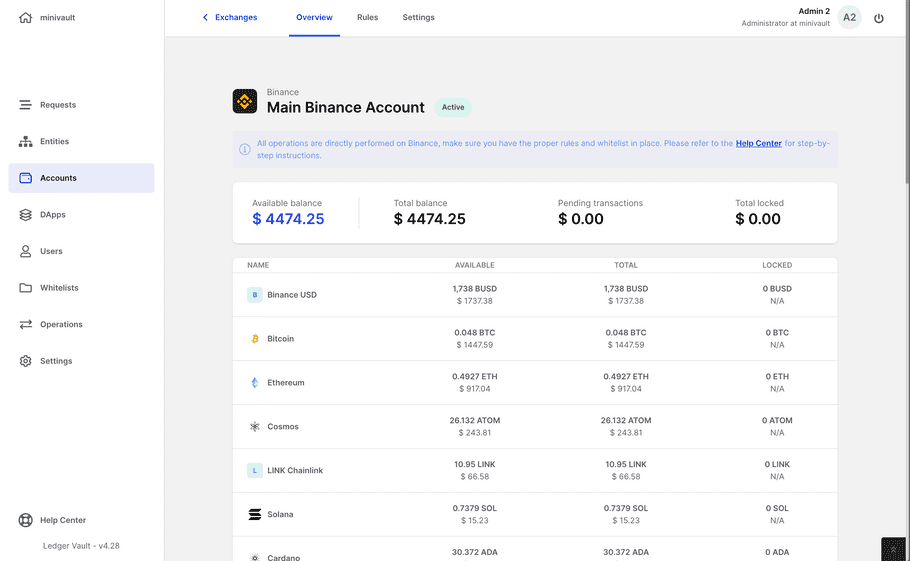
For detailed instructions and further information, please refer to the detailed documentation.
Operator capabilities for liquidity management will be added in a future release. As always, if you have any questions or encounter any issues, our support team is here to assist you.
Ethereum staking via API
We are excited to announce the launch of our new feature, which enables our users to stake Ethereum (ETH) using our API. Staking Ethereum has never been easier, and this functionality aims to provide our users with a seamless and efficient way to participate in Ethereum's proof-of-stake consensus mechanism.
Our API integration for Ethereum staking simplifies the process for our users. You can now interact programmatically with our staking infrastructure, allowing you to stake ETH, manage your staking positions, and monitor your staking rewards.
Please find more information about Ethereum staking via API in out developer portal.
July 2023 - EVM Networks Direct Access
June 2023 - EVM Networks Direct Access
Overview
The growth and diversity of Ethereum Virtual Machine (EVM) compatible networks have created a multitude of opportunities for digital asset management. Ledger Enterprise is excited to introduce Direct Access to a wide range of EVM networks. This new feature allows our users to interact directly with these networks, create accounts, visualize balances, transact, and interact with DeFi and NFT applications.
Direct Access is a mode of support where Ledger Enterprise Platform communicates directly with EVM networks. This method allows users to explore and interact with a broader array of blockchains without the need for them to be fully indexed on our platform. With Direct Access, you can:
- Create accounts on these newly supported networks (Arbitrum, Optimism, Fantom, Flare, Klaytn, Avalanche C-chain, as well as their testnets, Mumbai and Sepolia)
- View your account balances for both parent and ERC20 children accounts
- Perform basic asset transfers
- Engage with DeFi and NFT applications on these networks
Please note that due to the nature of Direct Access (without full indexing), reporting capabilities are currently limited to outgoing transactions. Additionally, users should be aware of potential rate limitations on transactions that might impact their ability to perform actions rapidly or in high volumes. However, we plan on enabling Full Access on these networks in later iterations to provide comprehensive reporting and minimize such limitations. Until Full Access is available, users can use external tools, such as public explorers (e.g., ArbitrumScan), to retrieve additional information on their reporting.
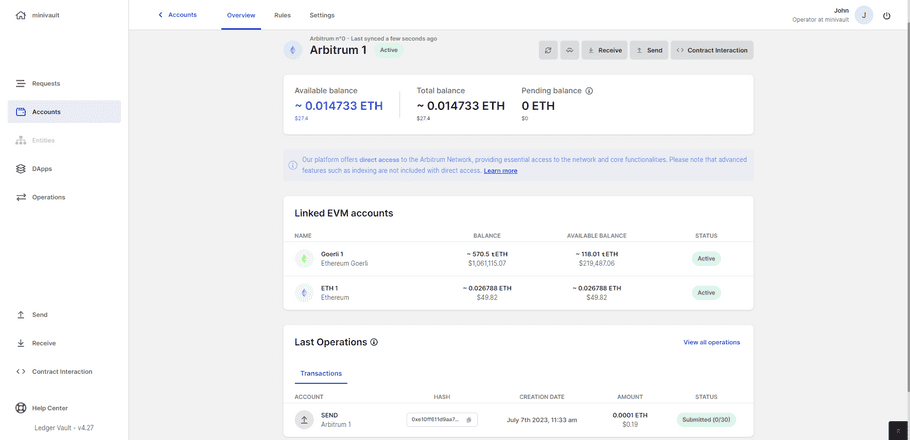
Learn more on how to leverage these new supported networks here.
June 2023 - Version 4.27.0: Tron with Vault Signer, EVM Message Signing, WalletConnect v2 support
June 2023 - Version 4.27.0
Overview
- Send and Receive TRON with Vault Signer and Ledger Live
- Sign Ethereum & EVM Messages - EIP-191 & EIP-712 support
- Interact wiht external DApps using WalletConnect v2
Tron with Vault Signer
The Vault Signer feature enables users to use an external wallet to craft a transaction, and then sign it on the Vault. The external wallet takes on the role of the crafter, while the Vault retains all control of the signer. This guarantees that transactions will still have to follow the governance rules enforced by the HSM. The biggest change is that the transactions will be crafted on the extension instead of the Vault.
In this first release of this feature the coin TRON will be available, with crafting operations done in Ledger Live.

Learn more here.
Sign Ethereum & EVM Messages - EIP-191 & EIP-712 support
Signing messages serves a crucial purpose in the web3 ecosystem. It allows users to confirm their identity, authenticate transactions, and interact with smart contracts without the need to share their private keys.
The EIP-191 and EIP-712 formats are Ethereum Improvement Proposals that standardize signed messages:
- EIP-191 provides a basic signed data scheme. It is mostly used to let users prove that they control an address without revealing their private key, typically when logging into a DApp.
- EIP-712 improves upon EIP-191 and makes the process of data signing more user-friendly. It displays the data in a structured and readable format, improving user understanding and control over what they are signing.
Ledger Enteprise now supports the signature of messages in both EIP-191 and EIP-712 formats, according to governance rules defined by admins, and enables operators to review their content on the Trusted Display of their Personal Security Devices.
The signature of messages with Ledger Enterprise accounts opens up multiple opportunities in the web3 ecosystem. Here are a few examples:
- Decentralized Finance (DeFi) apps such as MakerDao, Aave or Curve Finance often require users to sign transactions for lending, borrowing, or trading assets
- Decentralized Exchanges (DEXs) such as Uniswap or Sushiswap's trading process involve signing messages to authorize trades and liquidity provisions
- NFT Marketplaces such as OpenSea, Rarible or Blur involve transactions where users purchase, bid for, or transfer digital assets. These marketplaces often require message signatures to ensure these transactions are secure and valid.
- Identity and social apps such as ENS (Ethereum Name Service) or Lenster use signatures to verify identities, prove ownership or facilitate secure communication
- DAOs and governance apps such as Snapshot or Aragon often require members to sign messages to participate in voting and other governance actions.
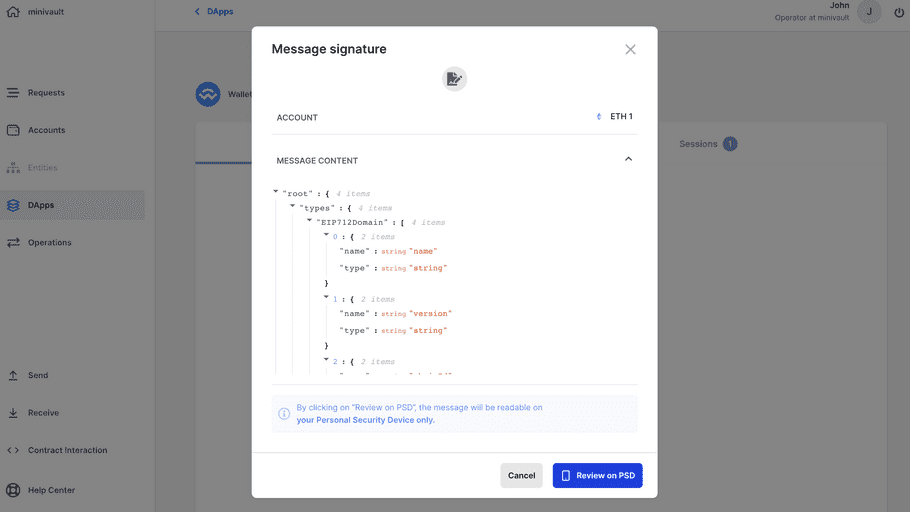
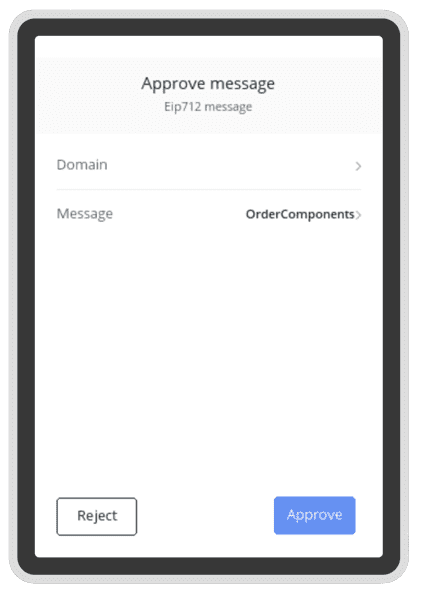
Learn more here.
Interact with external DApps using WalletConnect v2
With WalletConnect recently transitioning to version 2.0, we are delighted to announce the support for WalletConnect v2 on the Ledger Enterprise Platform. This update offers several improvements over the previous version and ensures that our clients can continue interacting with decentralized applications (DApps) using the WalletConnect application.
This upgraded version introduces several enhancements, such as improved performance, multi-chain support, and payload encryption for increased security (see here for more information). For a detailed understanding of WalletConnect v2, please refer to the official WalletConnect v2 documentation.
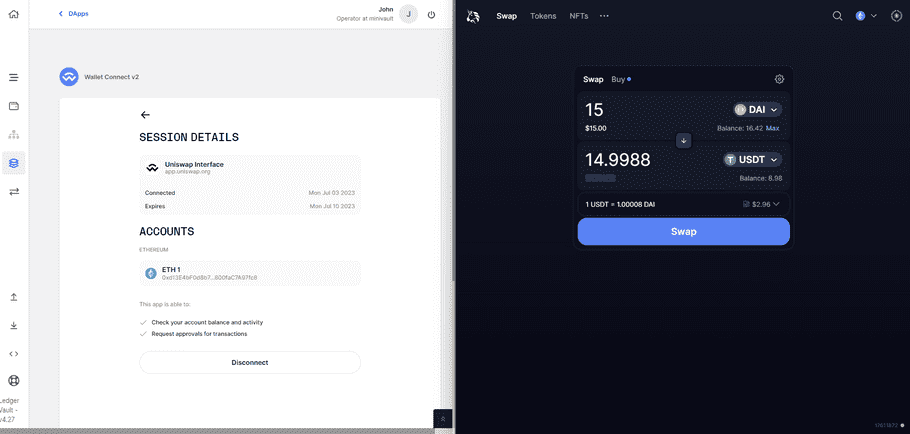
Learn more here.
June 2023 - Version 4.26.0: Ledgible integration & performance improvements
June 2023 - Version 4.26.0
Overview
- Performance improvements
- Integration with Ledgible's digital asset tax & accounting platform
Performance improvements
In this update, we focused on optimizing the Vault's underlying infrastructure and building foundations for some exciting features to come. Although you may not see any visible changes, we have updated several important components behind the scenes to continue making your overall experience smooth and reliable.
Integration with Ledgible's digital asset tax & accounting platform
You can now easily connect your Ledger Enterprise workspace to Ledgible's tax reporting and accounting platform. Automatically sync crypto transactions and holdings with Ledgible, track your portfolio, comply with tax regulations, and get real-time insights into your crypto assets.
June 2023 - Version 4.25.0: Cardano "Send Max", Ethereum staking rewards monitoring via API and DeFi & NFT improved reporting
June 2023 - Version 4.25.0
Overview
- Cardano: "Send Max" feature
- Ethereum & EVM: Monitor your staking rewards via API
- Ethereum & EVM: Improved DeFi/NFT reporting in the UI & .csv export
Cardano - Send Max
We are pleased to announce that our Cardano integration now includes the capability for users to empty their accounts. This feature has been highly requested by our users and can be particularly useful for accounting purposes.
Please note that this functionality still fully respects any governance rules that you may have in place for your account.
It is important to be aware that emptying an account is possible even if the account is registered for staking, allowing the deposit to remain in the account. However, if you wish to regain the deposit registration and ensure the ability to cover future fees, you will need to send back some funds to your account.
By following this process, you can maintain your staking arrangement and preserve the functionality of your account while still having the option to empty it when necessary.
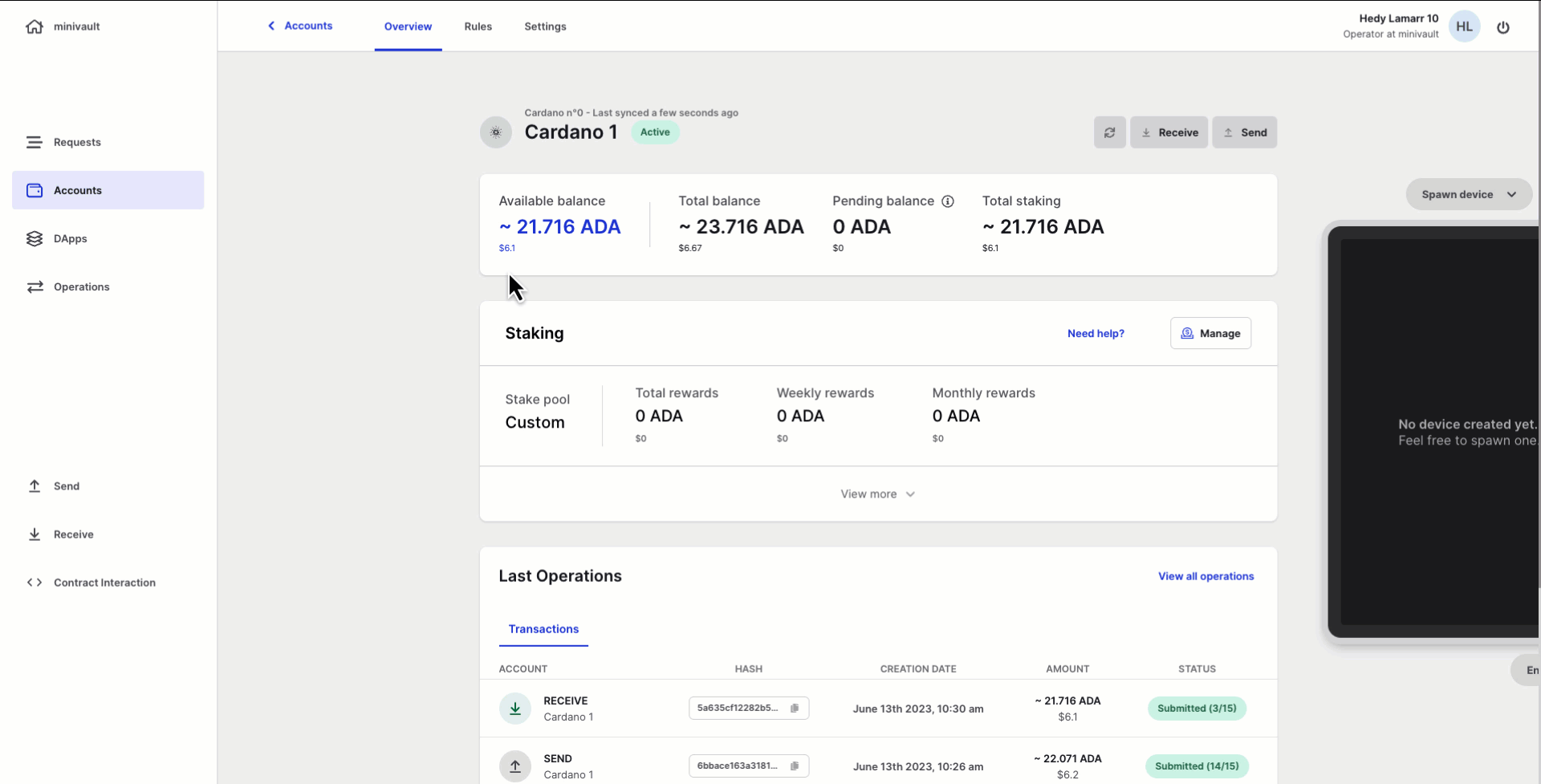
Ethereum: Monitor your staking rewards via API
If you have staked ETH from your Ethereum accounts, you can now track their entire rewards history with our dedicated Ethereum rewards API endpoint.
Ethereum & EVM: Improved DeFi/NFT reporting in the UI & .csv export with related events
This new feature allows users to review the details of the related events of their Ethereum transactions involving smart contracts, offering a deeper insight into their crypto assets operations. Whether you're swapping tokens on a decentralized exchange (DEX), dealing with ERC20 tokens or Non-Fungible Tokens (NFTs), or receiving ETH staking rewards, this feature provides comprehensive reporting, supporting enhanced auditability and risk management. You can learn more in the detailed section here.
May 2023 - Ethereum Staking full withdrawals support
May 2023 - Ethereum Staking withdrawals
Overview
- Staking: withdraw your Ethereum stakes & rewards
Ethereum Staking withdrawals with Kiln
We are happy to announce that you can now fully unstake and withdraw your staked assets on Ethereum, using Kiln's app. Withdrawn funds will be sent to the staking account (the account that initiated the stake) and cannot be retrieved on any other address to prevent any human mistake or malicious attack.
Note that just like staking, unstaking is not immediate. Your unstaked validators will be processed in the exit queue. Once they have reached the exited state, funds will become withdrawable after 256 epochs (~27 hours). You can learn more about the validator lifecycle and exit flows here.
Please head to the dedicated user documentation to learn more on how to manage your ETH Stking positions with Kiln.
May 2023 - Version 4.24.0: Cardano Transaction History, NFT/ERC-20 Portfolio monitoring via API & Performance Improvements
May 2023 - Version 4.24.0
Overview
- Cardano: Transaction history
- Ethereum & EVM: Monitor your NFT & ERC20 portfolio via API
- API Performance improvements
Cardano - Transaction history
Our Cardano integration has been delivered in two phases. In the first phase, users were able to perform regular transactions and engage in staking activities. However, incoming transactions reporting was not supported at that time.
With this new release, users will now have access to a comprehensive transaction history and reporting feature, covering all transactions conducted in ADA. It provides improved visibility and tracking of transactions within the Cardano network.
However, it's important to note that the current version of the Vault does not support Native Tokens on the Cardano network. Native Tokens encompass all the tokens created on the Cardano blockchain, with ADA being the primary one. Presently, the Vault only supports ADA, and if you wish to store other Native Tokens, kindly contact your TAM (Technical Account Manager) to express your interest before initiating any transfers of Native Tokens to the Vault.
Ethereum & EVM: Monitor NFT & ERC-20 porftolio via API
If your EVM accounts (Ethereum, Polygon, BNB & many more coming soon) hold NFTs or ERC-20 tokens, you can now track their entire token portfolio with our dedicated NFT & ERC-20 API endpoints:
- Track your NFT Portfolio
- Retrieve your NFT Collections
- Retrieve your NFTs
- Retrieve your ERC-20 child accounts
API Performance Improvement
We've enhanced the account retrieval endpoints in the Ledger Enterprise API. You'll now experience significantly faster response times and greater efficiency, making your account data access smoother and more efficient.
April 2023 - Version 4.23.0: Seamless API reporting & Secured Web3 interactions
April 2023 - Version 4.23.0
Overview
- Web3 checks: secure your web3 interactions
- Reporting API Keys
Web3 checks: secure your web3 interactions
We are excited to announce the latest addition to our Ledger Enterprise platform: Web3 Checks. This new feature aims to enhance the security and user experience for our institutional clients when interacting with DeFi and NFT protocols on the web3 ecosystem, through our contract interaction panel and WalletConnect.
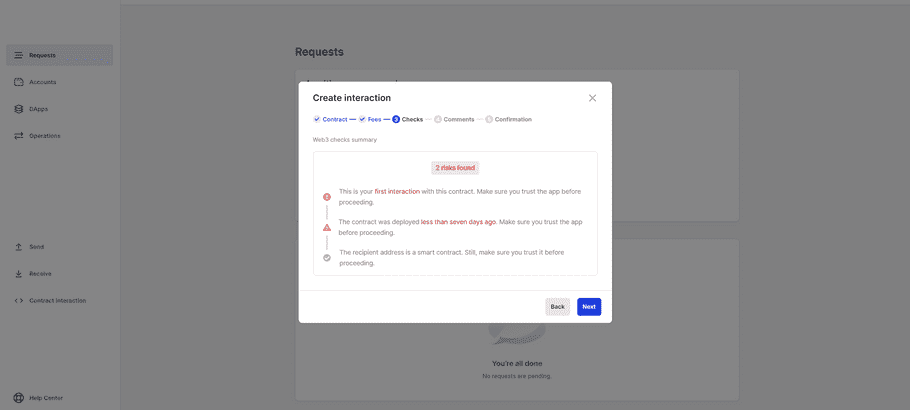
Find out more on this feature in the dedicated articles:
Reporting API Keys
Workspace administrators can now generate and manage reporting API keys to access reporting and notification endpoints. This feature provides enhanced security and flexibility, enabling administrators to grant access to reporting data only to authorized users. To generate a new reporting API key, go to Workspace Settings and click on Ledger Enterprise Reporting API Keys.

Find out more on this feature in the dedicated articles:
April 2023 - Version 4.22.0: Performance improvements - Cardano - BSC SCI
April 2023 - Version 4.22.0
Overview
- Performance improvements: reduce waiting time
- Cardano: Custody and Staking
- Binance Smart Chain: Smart Contract Interactions support
- Enhanced EVM account management & segregation
- NFT Gallery: portfolio value
Performance improvements: reduce waiting time
Following feedback from our clients, our latest security improvements have increased the delay to sign transactions. Without giving back on security we heard you and manage to reduce the waiting time by a factor of 2 to 4 depending on the governance of the account. More performance improvements are to come throughout 2023.
Cardano custody and staking
Cardano is out ! In this first release of Cardano features you can now:
- Enable custody : safeguard your ADA on the Vault platform with the complete governance model you're used to have with other coins.
- Stake your ADA : Begin staking Cardano with our staking partners' functionnalities, or use your own validator if you prefer to play on your own.
Please contact your technical account manager for the staking functionalities if you are not already exposed to it. The support of the Cardano testnet and the transaction history will come in the next couple of months to complete the Cardano support.
Find out more on how the Cardano staking feature works here.
Interact with Smart Contracts on the Binance Smart Chain
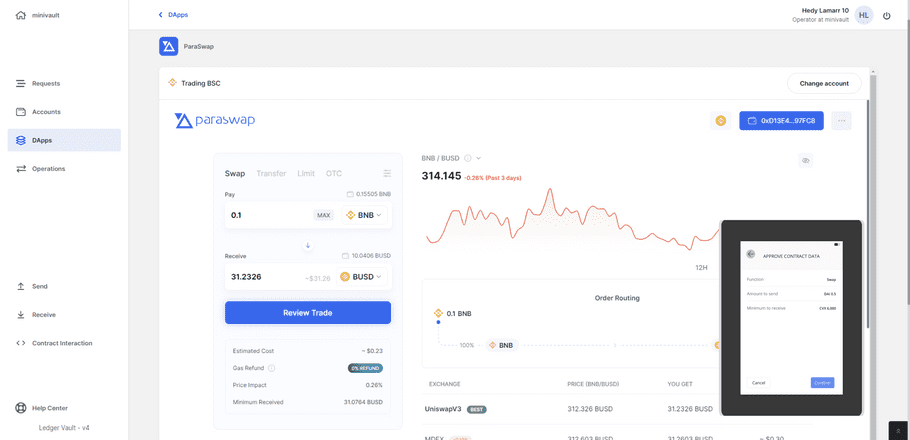
You can now interact with any smart contract based applications on Binance Smart Chain, and benefit from the low fees of the network to optimize your web3 operations, whether it be DeFi or NFT. Ledger Enterprise provides the same level of support as on Ethereum:
- Administrators can configure smart contract enabled accounts on BSC, and define a dedicated governance rule for interacting with web3 apps on BSC.
- Operators can access Vault DApps on BSC directly on their workspace, featuring Paraswap for now (and more to come).
- Operators can interact with any BSC contract using the Contract Interaction panel - provided the contract has its ABI published on BscScan.
- Operators will be able to Clear Sign their BSC smart contact interactions on Trusted Display for all supported contracts (see: Supported ClearSign contracts & applications ), bringing unparallelled security to web3 operations.
- All interactions with web3 apps on BSC can be achieved through the Public API . Please refer to the documentation here: Ledger Enterprise API .
Improved management & segregation of EVM (Ethereum, Polygon, BSC) accounts
The standard approach to managing accounts on EVM networks is to generate the same public address (from a given private key) across all these networks, so that users can seamlessly interact with various networks while maintaining a single public address. Moreover, as a custodian managing multiple customers' accounts, it's essential to have an organized and secure system for managing accounts.
Therefore, Ledger Enterprise Administrators now have the flexibility to create accounts with two distinct options:
- Linked Accounts : These accounts are connected to another account on a different supported EVM network. This means they share the same address (or index), making it easier to manage assets across multiple EVM-compatible chains with a single public address. This is particularly useful for institutions requiring seamless cross-chain interactions and simplified account recovery in case of funds sent to the wrong network.
- Unlinked Accounts : For institutions that prefer to have unique, unused addresses (for added privacy and security) and for custodians that need to segregate each of their clients' funds, we also offer the option to create accounts with a new, unshared address. This means the public address of the account is not associated with any other account on another supported EVM network.
Note that prior to this feature, all your Ledger Enterprise accounts follow the second option (unlinked accounts), meaning that they all have a unique address that is not shared by another account on another network.
For more information on this new account creation flow, please head to this article.
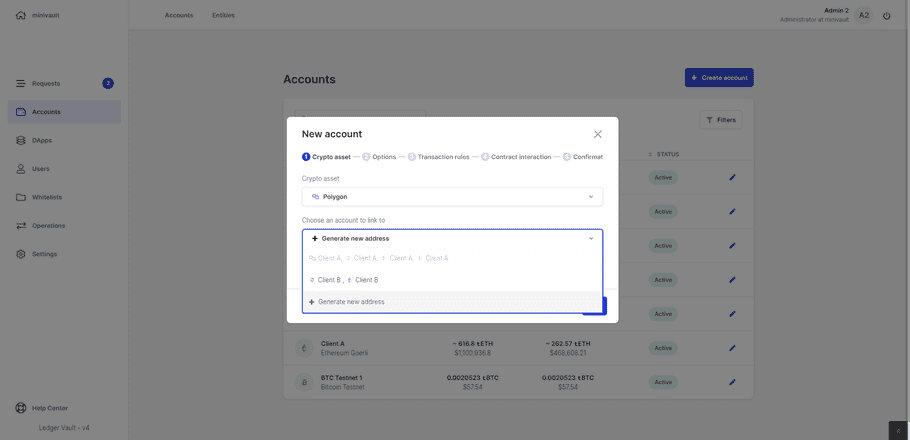
NFT Gallery: portfolio value
We're excited to announce the latest improvement to our NFT gallery feature on our Vault! You can now view the floor price of your NFTs. This feature will enable you to track the minimum price that your NFTs are being traded for in the market. You’ll also be able to see the overall balance and quantity of your NFT collection, which will be displayed on the NFT Gallery page. This balance is kept distinct and not included in the overall balance section which is featured at the top of your account.
Moreover, you can now click on any NFT token in your collection, and it will take you to a new page that displays its characteristics. This feature will provide you with more detailed information about your NFTs, including their properties, quantity and token standard, as well as links to open markets.
Technical release improvement
We improved part of our release process for our nexts releases reducing the maintenance time for small releases. More info during our 4.23 release.
March 2023 - Version 4.21.0: Smart Contract Whitelist
March 2023 - Version 4.21.0
Better manage your gouvernance rules: introducing Smart Contract whitelists
The Smart Contract Whitelist feature enables Administrators to efficiently secure and manage their organization's accounts rules by distinguishing between Smart Contract and Transaction Whitelists. By creating separate whitelists for each type of governance rule, administrators can reduce the risk of errors and streamline the overall governance process.
Additionally, the feature allows for easy whitelisting of supported contracts through a user-friendly dropdown menu containing all Clear Signed contracts, simplifying the process of adding trusted contract addresses and enhancing overall asset security.
February 2023 - Version 4.20.0: Binance Smart Chain: Send & Receive
February 2023 - Version 4.20.0
BNB Send & Receive
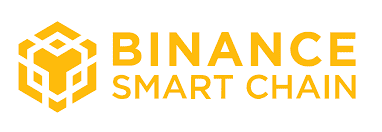
You can now create Binance Smart Chain (BNB) accounts in your Ledger Vault workspace to send and receive funds. BSC brings to 18 our list of supported crypto assets and over 5,000 ERC20 tokens.
We’ll be adding the possibility of conducting smart contract interactions on BSC in a future release.
Creating a BNB account and transaction is similar to any other crypto asset. Follow the instructions on Create an account and Create a transaction for more information.
February 2023 - Version 4.19.0: ClearSign your NFT operations on your device
February 2023 - Version 4.19.0
Don’t trust, verify: ClearSign your NFT operations on Trusted Display
You can now manage your NFTs directly from your Gallery while benefiting from the best security on the market thanks to our ClearSign support. You will now be able to review the exact content of your NFT operations in a meaningful fashion on Trusted Display and verify that you are performing the right transactions on your Personal Security Device. For instance, Operators will be empowered to review that they are sending an NFT from the right collection, to the right recipient address.
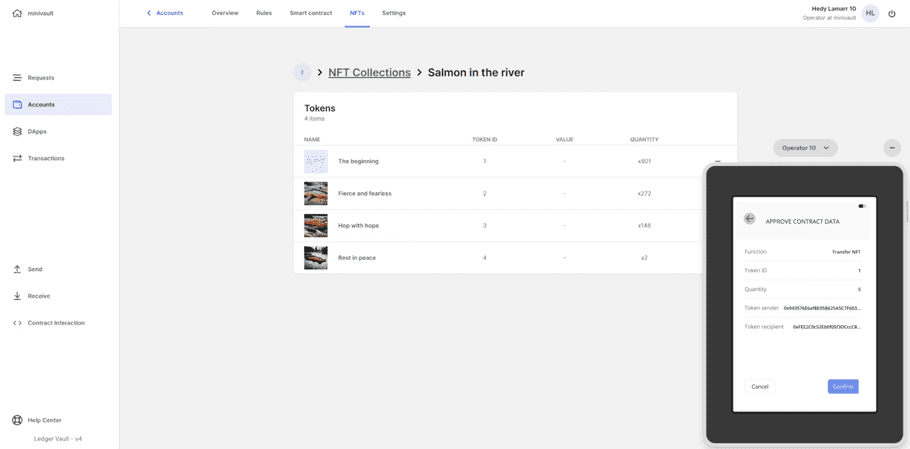
Ledger Enterprise will now ClearSign all standard functions of ERC-721 and ERC-1155 contracts. You can review supported ClearSigned contracts here.
Stake MATIC directly from your Ledger Enterprise Platform
We are happy to announce that you can now generate yield on your idle MATIC assets by staking them directly from your Ledger Enterprise platform.
Staking MATIC brings many benefits, including:
- High yield : Polygon leverages (D)PoS (Delegated Proof of Stake) as its consensus mechanism. There are up to 100 validators ensuring the security of the Polygon network, and any MATIC holder can become a delegator by bonding their assets to their preferred validator. By doing so, delegators can earn up to 5-6% APR (i.e. 3% adj.).
- Low risk : Polygon manages delegations in a trustless fashion, via a robust set of smart contracts. Additionally, staking via Ledger Enterprise empowers you to review your staking operations in a meaningful fashion on trusted display thanks to our ClearSign framework on supported smart contracts.
- Simplicity & scalability : you can use Ledger Enterprise to stake directly on Polygon Staking applications, from the UI. Should you want to automate your staking workflows to scale your operations, you can also leverage our Public API to perform your delegations and withdrawals programmatically. You can find out more about our API here .
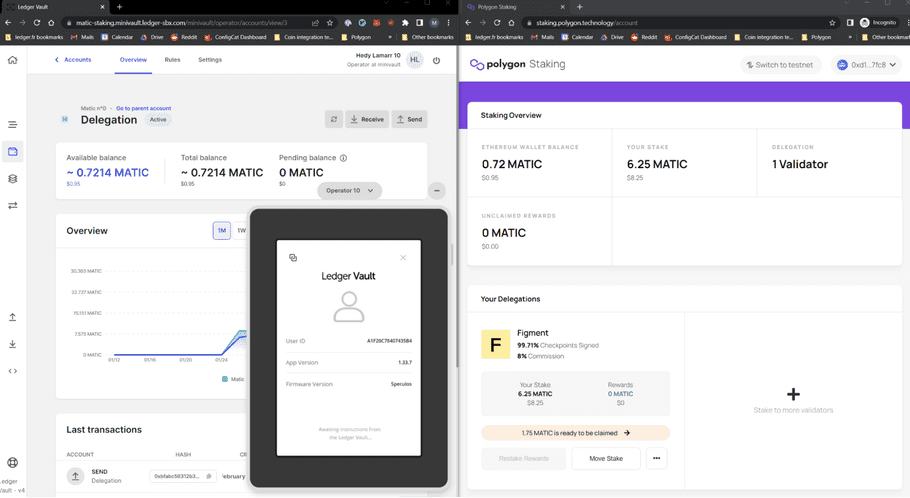
If you want to learn more about staking MATIC, check this dedicated article on the help center.
BNB Send & Receive

You can now create Binance Smart Chain (BNB) accounts in your Ledger Vault workspace to send and receive funds. BSC brings to 18 our list of supported crypto assets and over 5,000 ERC20 tokens.
We’ll be adding the possibility of conducting smart contract interactions on BSC in a future release.
Creating a BNB account and transaction is similar to any other crypto asset. Follow the instructions on Create an account and Create a transaction for more information.
January 2023 - Version 4.17.0: Customize your DApps catalog across EVM accounts
January 2023 - Version 4.17.0
Customize your DApps catalog across EVM accounts
We continually work to expand our DApp catalog, so you can fully embrace web3 right from your LE platform. Our aim is to cover a wide range of use cases and empower you with best-in-class tools to craft governance flows tailored to your requirements. The new customization feature now allows Administrators to fine-tune DApp access for each account and effectively control which DApps an Operator can access.
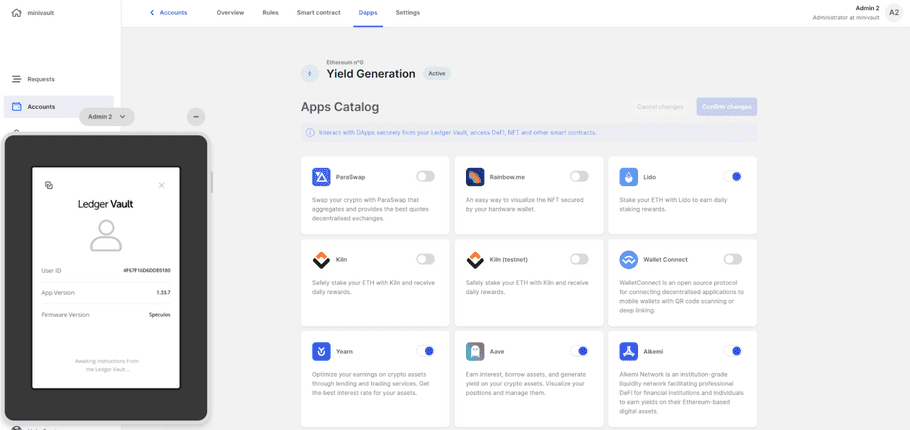
Find out more information on how to configure your account to choose exactly which DApps you want to connect to here.
January 2023 - API Version 1.7.1
January 2023 - API Version 1.7.1
Solana staking endpoints fixed
A new LAM version 1.7.1 has been released to fix Solana Staking API endpoints. Please pull this latest version in order to have a flawless experience when interacting with Solana Staking via API. You can find the API documentation here.
January 2023 - Version 4.16.0: Staking on the Solana blockchain
January 2023 - Version 4.16.0
Staking on the Solana blockchain
This first release note of 2023 is an exciting one! We're happy to announce that it is now possible to conduct Solana staking operations directly on the Ledger Enterprise platform.
There are many benefits of staking Solana with Ledger Enterprise. The process is:
- Simple, yet rewarding : Staking Solana on Ledger Enterprise only requires a few clicks to generate up to 5.5% APY. You will be able to manage all of your staking positions in one place without needing prior knowledge of the network and with no extra cost.
- Secured & Low risk : Protect against mismanagement of funds by having staking transaction checks at a hardware level before signing. This will enforce that only your Vault account retains control and receives the rewards. Additionally, slashing risks are fully mitigated by our validator partners, thus enabling institutional staking with security and peace of mind.
- Flexible and scalable : You can manage as many on-chain staking positions as you need from just one account on the LE platform. This allows you to stake more without undelegating your previous staking position and partially withdraw staking positions so you don’t lose time or rewards. It also lets you manage with ease new restrictive regulations, by tracking precisely all your end-user stakes as one on chain address. This implementation is even possible via API, if you are looking for scaling solana staking as user demand grows.
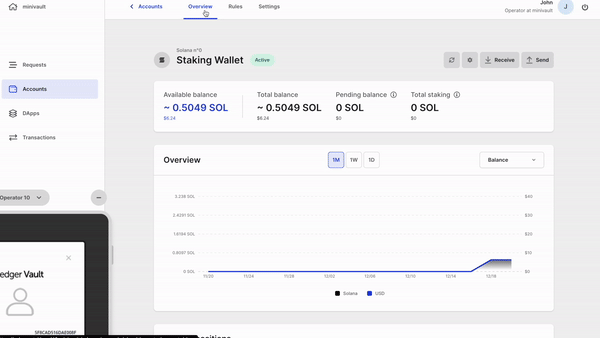
If you want to learn more about staking Solana, check this dedicated article on the help center. To learn more about how you can use Ledger API to scale your day to day operations, please don’t hesitate to schedule a call with our team.
Extending our DApps Catalog: Welcome Lending DApps!
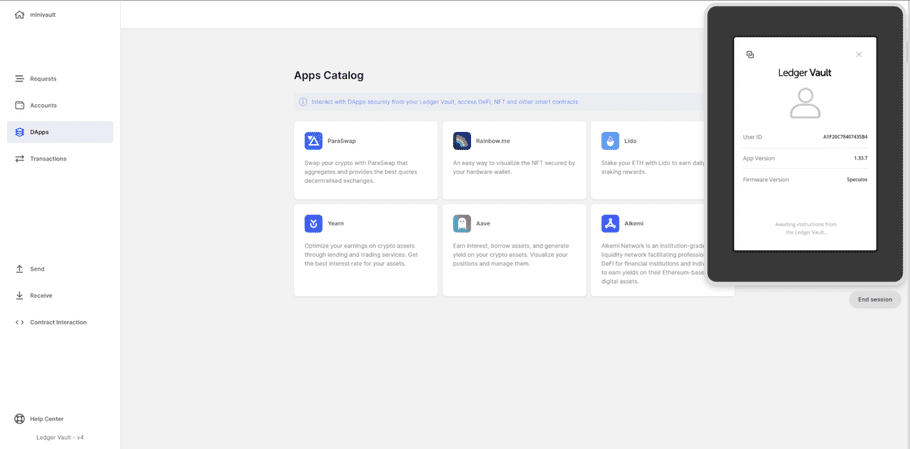
Operators can now access three new DApps (Decentralized Applications) directly from their !Ledger Enterprise DApps Catalog: Aave, yearn.finance and Alkemi. These DApps empower users to lend and borrow assets, earn passive income, and define strategies to farm yield. Operators will be able to interact with these applications in a secure fashion, benefitting from our Clear Sign framework and first-class security when interacting with these contracts. You can review the list of supported Clear Sign contracts here.
Want to learn more? The following articles give a step-by-step guide on how to use these DApps on the Vault:
- Aave: Access Aave on Ledger Vault
- Alkemi: Access Alkemi on Ledger Vault
- Yearn: Access Yearn on Ledger Vault